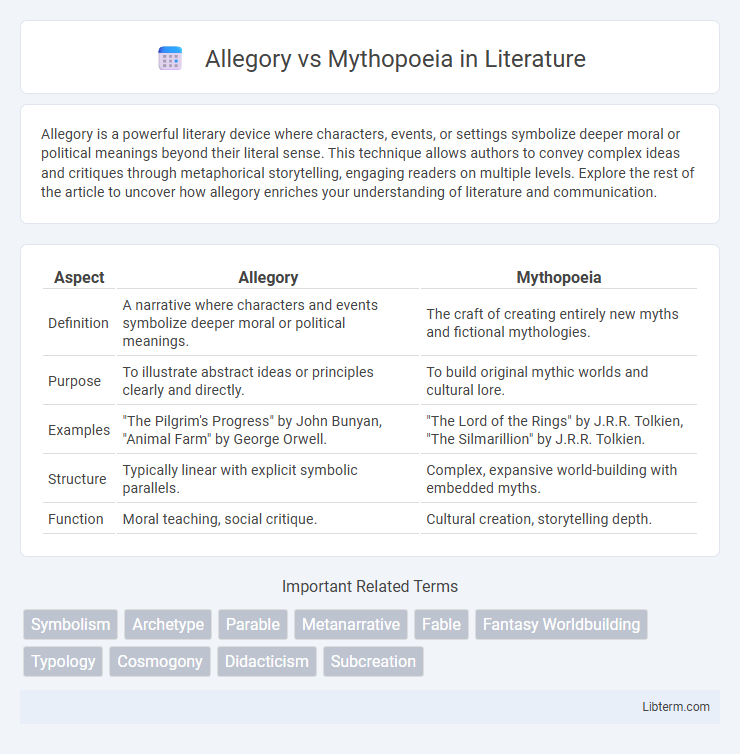Allegory is a powerful literary device where characters, events, or settings symbolize deeper moral or political meanings beyond their literal sense. This technique allows authors to convey complex ideas and critiques through metaphorical storytelling, engaging readers on multiple levels. Explore the rest of the article to uncover how allegory enriches your understanding of literature and communication.
Table of Comparison
| Aspect | Allegory | Mythopoeia |
|---|---|---|
| Definition | A narrative where characters and events symbolize deeper moral or political meanings. | The craft of creating entirely new myths and fictional mythologies. |
| Purpose | To illustrate abstract ideas or principles clearly and directly. | To build original mythic worlds and cultural lore. |
| Examples | "The Pilgrim's Progress" by John Bunyan, "Animal Farm" by George Orwell. | "The Lord of the Rings" by J.R.R. Tolkien, "The Silmarillion" by J.R.R. Tolkien. |
| Structure | Typically linear with explicit symbolic parallels. | Complex, expansive world-building with embedded myths. |
| Function | Moral teaching, social critique. | Cultural creation, storytelling depth. |
Defining Allegory: Unveiling Hidden Meanings
Allegory is a literary device where characters, events, and settings symbolize deeper moral, political, or spiritual meanings, revealing hidden layers beyond the literal narrative. Unlike mythopoeia, which involves the creation of entirely new mythologies, allegory functions by mapping known symbols onto an existing framework to convey abstract ideas and ethical lessons. This technique invites readers to interpret the surface story through a symbolic lens, unlocking complex themes embedded within the text.
What is Mythopoeia? Crafting New Myths
Mythopoeia refers to the creative process of crafting new myths or mythologies, often blending original narratives with symbolic meanings to explore universal truths. Unlike allegory, which uses existing stories to convey moral or political messages, mythopoeia invents entirely new mythic frameworks that resonate with cultural archetypes and spiritual themes. This imaginative storytelling expands literary and artistic traditions by forming rich, immersive worlds that function as living mythologies.
Historical Roots: Allegory and Mythopoeia in Literature
Allegory traces its historical roots to ancient civilizations such as Greece and Rome, with seminal works like Plato's "Allegory of the Cave" illustrating complex ideas through symbolic narratives. Mythopoeia emerged more distinctly in the modern era, pioneered by authors like J.R.R. Tolkien, who crafted entire mythologies to explore universal themes and cultural identity. Both literary techniques serve to convey deeper meanings, but allegory relies on direct symbolism, while mythopoeia builds immersive, original mythic worlds as a form of narrative creation.
Core Differences Between Allegory and Mythopoeia
Allegory conveys abstract ideas or moral lessons through symbolic characters and events, often with a clear, one-to-one correspondence between symbol and meaning. Mythopoeia involves the creation of entirely new mythologies, generating complex worlds and narratives that function as a cohesive cultural or spiritual system. The core difference lies in allegory's didactic intent and symbolic transparency versus mythopoeia's imaginative world-building and deeper narrative complexity.
Symbolism in Allegory vs. Mythopoeia
Allegory employs symbolism as a direct vehicle to convey specific moral or political messages through characters and events representing abstract ideas, creating a clear, fixed interpretation. Mythopoeia, by contrast, constructs entire symbolic universes or mythic frameworks where symbols gain multifaceted meanings, allowing diverse and evolving interpretations across cultures and time. The symbolism in allegory functions as explicit signposts, while in mythopoeia, it thrives in layered narratives that evoke archetypal themes and collective unconscious motifs.
Purpose and Function: Moral Lessons vs. World-Building
Allegory serves the purpose of conveying moral lessons through symbolic representation, enabling readers to interpret deeper ethical meanings behind characters and events. Mythopoeia focuses on world-building by creating complex, immersive mythologies that establish cultural identities and provide explanations for natural phenomena. While allegory emphasizes instructive narratives, mythopoeia prioritizes imaginative creation of entire mythic frameworks.
Famous Allegories: Classic and Modern Examples
Famous allegories include John Bunyan's "The Pilgrim's Progress," which uses symbolic characters and events to depict the Christian journey of salvation, and George Orwell's "Animal Farm," an allegorical critique of totalitarianism through a tale about farm animals. Modern examples such as Margaret Atwood's "The Handmaid's Tale" illustrate social and political commentary by embedding deeper meanings within a dystopian narrative. These works demonstrate how allegory uses metaphor and symbolism to convey moral, spiritual, or political messages distinct from mythopoeia's creation of entirely new mythological worlds.
Notable Works of Mythopoeia in Contemporary Culture
Notable works of mythopoeia in contemporary culture include J.R.R. Tolkien's "The Lord of the Rings," which crafts an intricate secondary world with its own mythology and languages. C.S. Lewis's "The Chronicles of Narnia" series intertwines mythic elements within a moral framework, creating rich allegorical narratives grounded in mythopoeic storytelling. Neil Gaiman's "American Gods" modernizes mythopoeia by blending ancient deities with contemporary American culture, exploring how myths evolve and persist in the modern world.
Authorial Intent: Interpreting Hidden Layers
Allegory explicitly encodes intended meanings through symbolic elements crafted by the author to convey moral or political messages, guiding readers toward specific interpretations. Mythopoeia constructs entirely new mythologies with immersive narratives that often invite open-ended analysis, reflecting broader cultural or existential themes rather than singular authorial intent. Understanding the distinction between these methods hinges on recognizing how authorial intent shapes whether layers of meaning are directly signposted or organically embedded in world-building.
The Enduring Impact: Allegory and Mythopoeia Today
Allegory and mythopoeia continue to shape contemporary storytelling by providing frameworks that infuse narratives with layered meanings and imaginative world-building. Allegory uses symbolic representation to convey moral, political, or spiritual messages, resonating deeply in literature, film, and art. Mythopoeia crafts entirely new mythologies, enriching cultural landscapes and influencing genres such as fantasy and speculative fiction with enduring cultural significance.
Allegory Infographic

 libterm.com
libterm.com